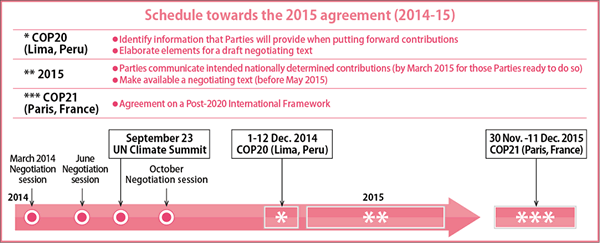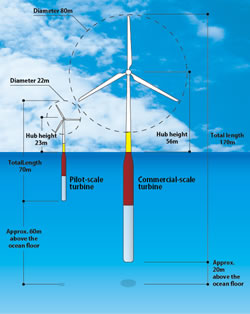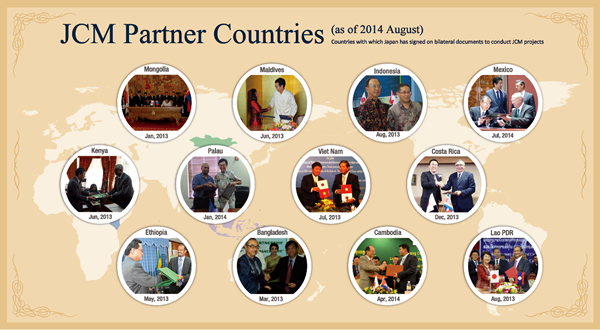Current topics
Post-2020 International Framework for Climate Change
Japan's Perspectives
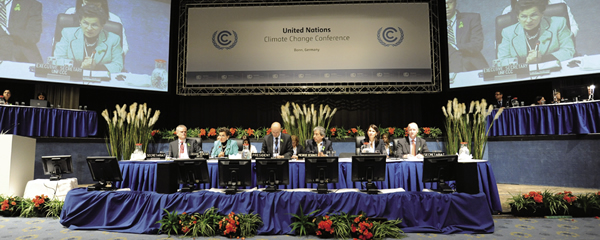
June negotiation session in Bonn, Germany (Source: UNFCCC)
International negotiations under the United Nations Framework Convention on Climate Change are currently underway towards an agreement on a post-2020 framework for climate change at COP21 in 2015. Japan regards the following 3 points as critical elements of the 2015 agreement.
Firstly, the legal obligation for all Parties to submit mitigation targets (nationally determined contribution: NDC) should be an integral part of the 2015 agreement. NDCs should be submitted in a way that allows comparing, evaluating and reviewing the performance and efforts of each Party as well as evaluating aggregated contributions towards global emissions reduction.
Secondly, all Parties should be subject to a transparency mechanism including an ex-ante consultation process, whereby each Party undergoes international consultation of its intended contribution before submitting an official NDC as well as an international evaluation and review process of each Party's performance towards the achievement of its NDC.
Lastly, adaptation to the adverse effects of climate change is a global challenge and an important component of the 2015 agreement. Each Party should be encouraged to integrate adaptation into its national planning and development process under the 2015 agreement.
COP20 is a crucial milestone at which Parties need to reach a decision on elements of the 2015 agreement, information that Parties will provide when putting forward their contributions and next steps in the negotiation process towards COP21. Japan is ready to engage with other Parties in an active and constructive manner by highlighting the aforementioned points.
More Information:
Floating Offshore Wind Turbine Demonstration Project
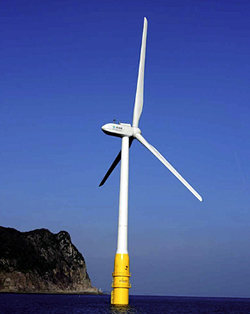
2MW demonstration turbine floating off the coast of Kabashima in Goto City, Nagasaki
Japan is a marine nation with the 6th largest exclusive economic zone in the world. Among renewable energy, offshore wind power holds the greatest potential in Japan. Moreover, with higher wind speed and less power fluctuation, the ocean promises more stable and efficient power generation compared to the land. Therefore, the utilization of offshore wind power is of essential importance for Japan.
There are two types of offshore wind turbines: one, a bottom-mounted type, is fixed at the seabed at a depth of up to 50 meters. The other, a floating body type, floats on the sea much like a buoy. Not having a large area of shallow seas, Japan expects much from floating turbines that can be introduced to deep sea areas (50m or deeper). However, the floating type has only been demonstrated twice - in Norway and in Portugal - and has not yet been installed in Japan.
Therefore, the Ministry of the Environment (MOE) has implemented a demonstration project to install and operate Japan's first 2000kW floating offshore wind turbine off the coast of Goto City, Nagasaki Prefecture. In June 2012, MOE installed and began operating a 100kW demonstration turbine at the pilot scale. The first of its kind, this turbine successfully survived a direct hit of a typhoon in September 2012. In October 2013, MOE installed and began operating a 2000kW demonstration turbine at the commercial scale. Through this project, we will continue working towards the early, practical utilization of power generation. Our aim is to increase offshore wind power to more than one million kW by the year 2020.
More Information:
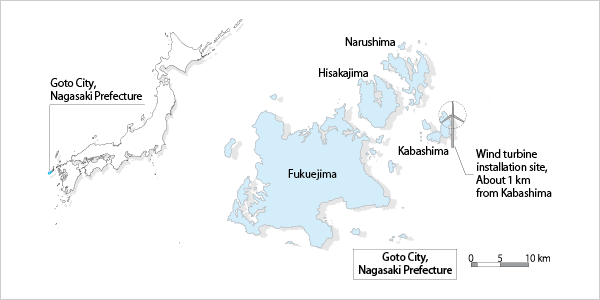
Demonstration site
Progress in the Joint Crediting Mechanism (JCM)
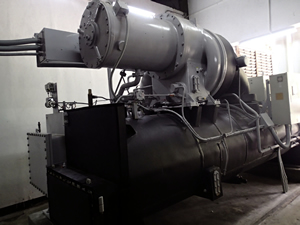
JCM Model Project for high efficiency chiller (ID)
Japan is actively promoting the establishment and implementation of the "Joint Crediting Mechanism (JCM)" in which Japan facilitates the diffusion of leading low carbon technologies, products, systems, services, and infrastructure as well as implementation of mitigation actions, and contributes to sustainable development of developing countries. After an appropriate evaluation of the contribution to GHGs emission reductions or removals in developing countries, Japan will use the generated JCM credits toward achieving its emissions reduction target.
Japan has signed bilateral documents for JCM with 12 countries as of August 2014: Mongolia, Bangladesh*, Ethiopia, Kenya, Maldives, Viet Nam, Lao PDR, Indonesia, Costa Rica, Palau, Cambodia and Mexico. As consultations with other developing countries are still underway, the number of participating countries is expected to increase.
The Ministry of the Environment (MOE) is supporting the formulation of projects through the JCM financing scheme. The scheme consists of: i) Financing Programme for the JCM Model Projects; ii) Funds for Expansion of Low-carbon Technologies; and iii) Asia Development Bank (ADB) Trust Fund. With regard to the JCM model projects, there are 15 on-going, two of which have already installed equipments with low-carbon technologies and started operating in 2014. MOE is also conducting capacity building programs for JCM rules and guidelines as well as feasibility study programs for JCM projects.
Japan will continue to recruit new partner countries and support the formulation of new projects in order to promote JCM.
More Information:
* Bilateral Offset Credit Mechanism is used as the name for this mechanism.


